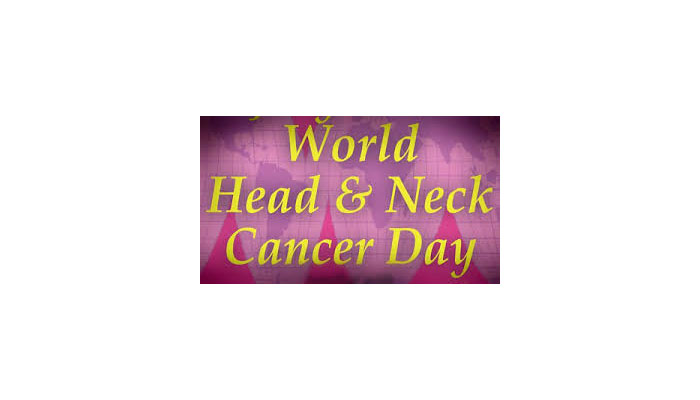‘Head and neck cancers cause 650,000 deaths annually worldwide’
“Head and neck cancer is the seventh most common cancer worldwide, accounting for three per cent of all cancers, with approximately 900,000 new cases and around 650,000 head- and neck-related deaths annually,” said Prof Tauqir Ul Islam, consultant oral and maxillofacial surgeon and head of the department at the Liaquat National Hospital and Medical College, Karachi, at a webinar on Saturday.
The event was held by the neurospinal and cancer care institute to strengthen the existing efforts to raise awareness and increase people’s understanding of head and neck cancers and to take steps to reduce their risk of developing these types of cancers. Experts also discussed the recent advances in the modern treatment of head and neck cancers in Pakistan.
“Cancers that are known collectively as head and neck cancers usually begin in the squamous cells that line the moist, mucosal surfaces inside the head and neck (for example, inside the mouth, the nose and the throat). These squamous cell cancers are often referred to as squamous cell carcinomas of the head and neck.
“Head and neck cancers can also begin in the salivary glands, but salivary gland cancers are relatively uncommon. Salivary glands contain many different types of cells that can become cancerous, so there are many different types of salivary gland cancers, and rarer tumours like para pharyngeal space tumours, nerve sheath tumours, sarcomas -- but are rare,” Prof Tauqir Ul Islam elaborated.
Head and neck cancers affect men more often than women, at a ratio of about 3:1. Typically, they present in elderly males, but recent data suggests a shift towards younger age groups, most cases occur in adults aged between 31 and 49 years, probably due to the rising numbers of population with an early age of initiation of habits, according to Prof Tauqir Ul Islam.
The mortality of these cancers has been reported to be quite high in our demographic, as most of the affected are present at an advanced stage, making them quite expensive for an emerging economy like Pakistan. If diagnosed early, the survival has been shown to be quite good for these cancers, he added.
Prof Tauqir Ul Islam Said, “The most prominent risk factors for head and neck cancers are tobacco and alcohol consumption, human papillomavirus (HPV) and Epstein-Barr Virus (EBV). The most common viruses related to head and neck cancers that are involved in cell transformation are the human papillomavirus. At least 12 per cent of pharyngeal cancer, three per cent of oral cancer, and 30–60 per cent of oropharyngeal carcinoma cases are caused by HPV infection.”
Additionally, betel nut-chewing, pan masala and gutka, occupational or environmental toxins, radiation exposure, particular preserved foods, poor dental hygiene and periodontal disease are also risk factors for the development of head and neck cancers. Quitting smoking or stopping the use of any tobacco products, including shisha, is probably the single most effective way to reduce the risk of developing a cancer in the head or neck, Prof Tauqir added.
Prof Tauqir Ul Islam said symptoms of head and neck cancers depend on a variety of factors, including the area of cancer growth, and should be taken seriously. The symptoms are persistent soreness in the mouth, nose, neck, or throat, enlarged lymph node in the neck (neck mass), trouble chewing or swallowing (dysphagia), hoarseness, (change in voice), or frequent cough, red or white patch in mouth or newly loose teeth, bad breath, frequent nosebleeds or nasal obstruction, jaw pain or difficulty opening your mouth, and paralysis of face along with different grades of difficulty in breathing. Radiating pain, numbness, regional nodal swelling, all suggests progression of the disease.
“In general, patients with early stage disease are treated with surgery or radiotherapy, whereas patients with advanced stage disease are treated by a combination of surgery, radiotherapy, chemotherapy and Immunotherapy. In all treatment modalities, progress has been made over the last decade. Surgical techniques are still evolving, with greater focus on minimally invasive procedures and better functional and esthetic outcomes. Apart from technical advances, progress has been made in refining indications for (salvage) surgery,” Prof Tauqir said.
“Improvements in diagnostic techniques may be useful in avoiding futile surgical procedures, for example, endoscopies and examinations under general anesthesia and elective and planned neck dissections. Sentinel node biopsy is a promising diagnostic technique to detect occult lymph node metastases, especially in oral carcinomas.”
“The armamentarium of reconstructive surgery is still expanding. Endonasal endoscopic, robotic surgery and image-guided surgery are used as minimal invasive surgery in selected patients,” Prof Tauqir explained.
“The goal of employing more immune system-empowering drugs is to make cancers less deadly, and perhaps even allow for cancer lesions to be controlled entirely by the patient’s own immune system by making them chronic instead of fatal,” said Dr Reena Kumari, consultant medical oncologist and assistant professor at Dr Ziauddin University Hospital, Karachi. She discussed the latest advances in head and neck cancer immunotherapy.
“Given the well-established role of immune system dysfunction in head and neck cancers, immunotherapy is an attractive treatment option, potentially associated with more improved efficacy and minimal tolerable side effects. These novel treatment modalities, either as monotherapy or combined with other forms, represent future directions in the treatment of head and neck cancers. Since 2010, new immunotherapy treatments have changed the direction of cancer care. Drugs called checkpoint inhibitors may now be used to treat more than a dozen cancers, including head and neck cancer,” Dr Reena explained.
“New discoveries about how changes in the DNA of cells in the oral cavity and oropharynx cause these cells to become cancerous are being applied to experimental treatments intended to reverse these changes. For example, clinical trials are testing whether it is possible to replace abnormal tumor suppressor genes of oral cancer cells with a normal copy, to restore normal growth control. Gene therapies to interfere with growth-stimulating effect of certain papillomaviruses are being developed. Another type of gene therapy adds new genes to the cancer cells to make them more susceptible to being killed by certain drugs,” she elaborated.
There is great potential in combining different treatments, including immunotherapeutic, cytotoxic chemotherapy and radiotherapy. It is therefore important to understand the interaction between different agents. Additionally, it is important to assess the efficacy of different schedules when combining multiple immunotherapeutic agents, in addition to traditional cytotoxic chemotherapy and radiotherapy, she further said.
Augmenting the anti-tumor immune response with other therapies could also improve immunotherapy response rates. Radiation therapy increasingly has been recognised to have diverse immunomodulatory effects, and there has consequently been intense interest in possible synergism between radiation therapy and immunotherapy, Dr Reena concluded.
-
 What's Buzzing Around TikTok's 'PineDrama' App: Everything You Need To Know
What's Buzzing Around TikTok's 'PineDrama' App: Everything You Need To Know -
 Who’s Next After Australia’s Under-16s Social Media Ban?
Who’s Next After Australia’s Under-16s Social Media Ban? -
 Do You Have Depression Or Is It Just Monday Blues? Find Out Where Science Stands
Do You Have Depression Or Is It Just Monday Blues? Find Out Where Science Stands -
 Why Claude Is Gaining Momentum In Revolutionizing The AI Landscape
Why Claude Is Gaining Momentum In Revolutionizing The AI Landscape -
 Elon Musk Unveils Plans To Take Humanity To The Moon And Mars
Elon Musk Unveils Plans To Take Humanity To The Moon And Mars -
 Air Pollution May Play A Role In Prostate Cancer Risk, Experts Warn
Air Pollution May Play A Role In Prostate Cancer Risk, Experts Warn -
 Royal Expert Reveals Real Reason King Charles Won't Meet Prince Harry Next Week
Royal Expert Reveals Real Reason King Charles Won't Meet Prince Harry Next Week -
 Ansel Elgort Welcomes His First Baby In Secret
Ansel Elgort Welcomes His First Baby In Secret -
 Startup Aims To Brighten Night Skies With Space Mirrors
Startup Aims To Brighten Night Skies With Space Mirrors -
 Cheaper Cars, Fewer EVs: Trump Administration Shifts ‘auto Policy’ Focus
Cheaper Cars, Fewer EVs: Trump Administration Shifts ‘auto Policy’ Focus -
 Meghan Markle Takes 'breadwinner' Role In Prince Harry's California Life
Meghan Markle Takes 'breadwinner' Role In Prince Harry's California Life -
 Type 2 Diabetes Hidden Trigger In Daily Food Revealed
Type 2 Diabetes Hidden Trigger In Daily Food Revealed -
 Vertical Tabs Coming To Google Chrome
Vertical Tabs Coming To Google Chrome -
 Jane Seymour Reveals THIS Beloved Romance Was 'worst-reviewed' Movie Ever
Jane Seymour Reveals THIS Beloved Romance Was 'worst-reviewed' Movie Ever -
 European Leaders Slam Trump’s Tariff Threat Over Greenland As ‘unacceptable’
European Leaders Slam Trump’s Tariff Threat Over Greenland As ‘unacceptable’ -
 Princess Eugenie Leaves Father Andrew 'devastated' With Big Step: 't's Brooklyn Beckham Level'
Princess Eugenie Leaves Father Andrew 'devastated' With Big Step: 't's Brooklyn Beckham Level'




